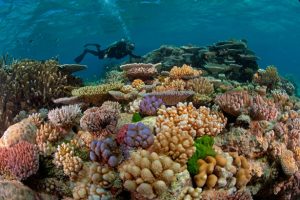Great Barrier Reef: Dead or alive?
By Sam Siomko, Staff Writer
The Great Barrier Reef is dead? Well, no one seems to have remembered to tell the reef that. An obituary for the world’s largest reef posted on Outside Magazine’s website did not check the facts before it announced the reef’s untimely death. There is no doubt that the Great Barrier Reef is in danger. Bleached corals and reduced fish diversity are just a couple of signs that this “sickness” is ravaging coral reefs across the globe. But even as climate change, pollution, and carbon in the atmosphere has hit an all-time high, much of the world’s largest reef is still alive and well.
Corals are made up of thousands of tiny polyp animals that exist in a symbiotic relationship with photosynthetic microorganisms called Symbiodinium. Bleaching occurs when the microorganisms are expelled from the coral after the coral has undergone some sort of stress, like a change in temperature or pH. Climate change is the culprit; the ocean’s temperature has risen 0.18oF on average. That may not seem like much, but corals have evolved to survive within a very small range of temperatures, and any increase can spell doom for these animals. Extra CO2 in the atmosphere is a danger as well by causing ocean acidification, a condition that makes it hard for corals to produce their skeleton.
However, bleaching does not mean the end for that coral. There is a short period of time when the coral can regain these microorganisms, and the coral can make a full recovery. If conditions do not improve though, the coral could starve to death without the microorganisms to produce nutrients. White coral is just bleached, but a dead coral will turn brown as algae grows on the skeleton. Extra CO2 in the atmosphere is a danger as well by causing ocean acidification, a condition that makes it hard for corals to produce their skeleton. Likewise, damage is done by human visitors to the reef, especially when corals are harvested for sale in gift shops.
Scientists have been on the case for years. The first major bleaching, even in the eighties, led to a whirlwind of research on why this was happening and what can be done to stop it. Policies were implemented, the reef became a “no take” zone for fishermen, and corals could no longer be harvested. However, most of the reef damage occurs on land. This includes agriculture, which adds fertilizers to the water and increases algal growth, as well as deforestation, which removes the number of trees available to soak up the excess carbon in the atmosphere.
There is a need for mainstream media outlets to cover stories that deal with conservation issues, such as what is happening to our reefs. Awareness is an important first step in protecting not just the reefs, but other ecosystems as well. However, an overly pessimistic report like Outside’s obituary can cause people to give up on trying to save something, especially if it seems like there is no hope. So, no, the reefs are not actually dead. If sweeping changes are made, there is a chance the reefs can recover, although it may not be to their full former glory. They may be dead soon though if nothing is done about their plight.

